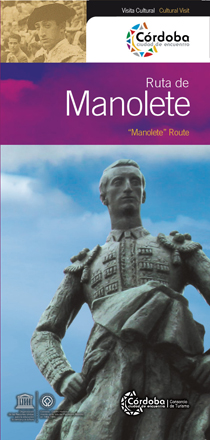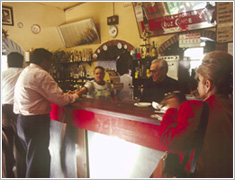 Click here to download MAP
Click here to download MAP
PLACES INCLUDED ON THE ROUTE:
Calle Conde de Torres Cabrera: Manolete was born in this street on 4th July 1917 at number 2A. A commemorative plaque was set up here when Rafael Salinas was Mayor of Cordoba.
Church of San Miguel: this is the parish where the bullfighter was baptized.
Plaza de la Lagunilla: after his father died, when Manolete was only five, his family moved from the house in Calle Conde de Torres Cabrera to a more modest home in Plaza de la Lagunilla. There, on the outskirts of the old slaughterhouse district and in close contact with his cousins, Manolete first showed interest in bullfighting. Cordoba Town Hall set up a bust in this square in 1951 in honour of the matador, a bronze copy of the marble bust made by sculptor Juan de Avalos.
Plaza del Conde de Priego: here stands the monument to Manolete, which was unveiled on the afternoon of Tuesday 8th May 1956 by the mayor of Cordoba Antonio Cruz Conde, and sculpted by Luis Moya and Manuel Alvarez Laviada.

“Los Salesianos” School: this is the school Manolete went to as a child.
Campo de la Merced: it was here where, while training at the beginning of 1936, he met the man who was to be his agent, former bullfighter Jose Flores Gonzalez Camara.
“El Lobaton”: this was the farm where Manolete took part in his first bullfights. It is located at 6km from Cordoba on the road to Castro del Rio.
“Cuevas de Artaza” Farm: Manolete also took part in bullfights here, near Medina Azahara.
“Dehesa de Yegüas” Farm: this farm belongs to the Sanchez Puerta family, in Guadalcazar, and Manolete spent long periods training here.
Montilla Bullfighting School: Manolete was a member.
Bujalance Bullfighting School: Manolete was a member.
Venta de Vargas Bullfighting School: this is the school where Manolete did most of his training. Owned by Federico Vargas, it was formerly situated on the Carretera del Brillante.
Cuesta del Reventon: from here, Manolete used to run up to the Hermitages as part of his training.
Former Artillery Barracks: here, in Avenida de Medina Azahara, Manolete was drafted into the army, though, apart from bulls, he never saw any fighting.
“El Carrascal” and “El Alcaparro” Farms: these two farms belonged to Manolete - “El Carrascal” is near the town of Hornachuelos and “El Alcaparro” is 19 km from Cordoba on the road to Castro del Rio. The latter still belongs to the bullfighter’s family.
Plaza de Capuchinos and Convent of San Jacinto: Manolete always showed great devotion to Our Lady of Sorrows. He gave donations to the religious community in the hospital.
Convent Church of San Cayetano: here Manolete was appointed as Head of the Bullfighters’ Fraternity.
Cabra: it was here where Manolete first appeared on posters, in a minor bullfight scheduled to take place on Carnival Sunday in 1933. The bullfight was suspended due to rain, but finally took place on April 16th, Easter Sunday, featuring Juanita Cruz and Manuel Rodriguez, alias "Palitos".
Santa Marina Tavern: just opposite the Church of Santa Marina. The tavern holds a range of memorabilia of the bullfighter’s life such as photos, notes, posters, newspaper cuttings, banderillas (bullfighting darts) and other items, which are kept there by the “Friends of Manolete” Club.
 La Sacristia Tavern: here, in Calle Alarcon Lopez, there is a collection of mementos of the bullfighter.
La Sacristia Tavern: here, in Calle Alarcon Lopez, there is a collection of mementos of the bullfighter.
La Fuenseca Tavern: this tavern, in Calle Juan Rufo, keeps photographs, mementos, notes and other items.
Rincon de las Beatillas Tavern: this is the headquarters of the Manolete Bullfighting Circle.
Manolete’s House on the Avenida de Cervantes (nowadays La Casa de Manolete Bistró): Manolete bought this house from the Cruz Conde family in 1942. It was restored by architect Carlos Saenz de Santa Maria, who was a great friend of the bullfighter. In this house he installed his chapel, and it was from here where the funeral cortège set out on the day he was buried. In this house, too, the philosopher Ortega y Gasset had spent his childhood.

Church of San Nicolas de la Villa: This church is where Manolete’s funeral was held. The funeral procession left the church and headed for the Plaza de la Lagunilla - from there it went up Calle San Pablo and Calle Claudio Marcelo to the Paseo de la Victoria on its way to the Nuestra Señora de la Salud Cemetery.
Nuestra Señora de la Salud Cemetery: Manolete was laid to rest in this cemetery, and since 15th October 1951, his remains have lain beneath a graceful recumbent statue carved in marble by the sculptor Amadeo Ruiz Olmos. On this date, his body was transferred from the Sanchez de Puerta family mausoleum, where it had been kept provisionally. The cemetery is situated in Avenida de los Custodios.
Manolete’s House Museum: in the town of Villa del Rio, this house conserves one of the most complete collections about the Cordoban bullfighter, made up of a large number of the bullfighter’s posters, photo archives, paintings, documents and personal belongings.
Paco Laguna, Manolete’s biographer, keeps his story alive through his writing. His best work is "Tauromaquia de Manolete"(Manolete’s Bullfighting) which includes over five thousand photographs. (Visits by appointment: Tel +34 957 176 053)
Los Califas Bullring: the owners of this bullring still conserve many mementos of the bullfighter in their private museum.
Los Tejares Bullring: the bullring now no longer exists, but the spot is marked by a raised plaque on a post. Manolete delighted his fans on numerous occasions in this arena.
The Manolete Municipal Trophy: three years after the bullfighter’s death in the Plaza de Linares, his fans, clubs and friends encouraged the City of Cordoba Municipal Commission for Fairs and Festivals to set up a scheme to organise an annual bullfighting event and a trophy dedicated to the memory of Manolete, affectionately known as “El Monstruo” (literally “the Monster”), to be awarded to the most outstanding bullfighter in the May Fair bullfights. The book containing the history of this trophy can be bought at the Cordoba Tourist Board’s Tourist Information Points.
Fecha inicio: 14-06-2007
Fecha fin: 18-10-2013